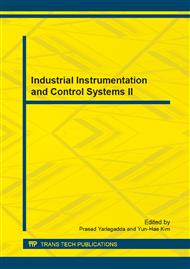[1]
Whitney, D., C. Lozinski, and J. Rourke,"Industrial robot forward calibration method and results," Journal of Dynamic Systems, Measurement, and Control, vol. 108, pp.1-7,1986.
DOI: 10.1115/1.3143737
Google Scholar
[2]
Everett, L.,"Models for diagnosing robot error sources," Robotics and Automation, 1993. Proceedings., 1993 IEEE International Conference on 1993: IEEE, vol.2,pp.155-159, May 1993.
DOI: 10.1109/robot.1993.292140
Google Scholar
[3]
R Roth, Z., B. "Mooring, and B. Ravani, An overview of robot calibration," IEEE journal of robotics and automation, vol.3(5),pp.377-385,1987.
DOI: 10.1109/jra.1987.1087124
Google Scholar
[4]
Elatta, A., et al.,"An overview of robot calibration. Information Technology," Robotics and Automation, IEEE Journal of,vol.3(1),pp.74-78.
Google Scholar
[5]
Duelen, G. and K. Schroer,"Robot calibration--Method and results,"Robotics and Computer-Integrated Manufacturing, vol.8(4), pp.223-231,1991.
DOI: 10.1016/0736-5845(91)90034-p
Google Scholar
[6]
Gong, C., J. Yuan, and J. Ni, "Nongeometric error identification and compensation for robotic system by inverse calibration," International Journal of Machine Tools and Manufacture, vol. 40(14), pp.2119-2137,2000.
DOI: 10.1016/s0890-6955(00)00023-7
Google Scholar
[7]
Mooring, B., M. Driels, and Z. Roth,"Fundamentals of manipulator calibration,", John Wiley & Sons, Inc. New York, NY, USA,1991.
Google Scholar
[8]
Abele, E., M. Weigold, and S. Rothenbucher,"Modeling and identification of an industrial robot for machining applications," CIRP Annals-Manufacturing Technology, vol.56(1), pp.387-390,2007.
DOI: 10.1016/j.cirp.2007.05.090
Google Scholar
[9]
Salisbury, J. and J. Craig,"Articulated hands: kinematic and force control issues," International Journal of Robotics Research, vol. 2(1),pp.4-17,1992.
DOI: 10.1177/027836498200100102
Google Scholar
[10]
Dumas, C., et al.,"Joint Stiffness Identification of Industrial Serial Robots," Robotica, p.20,2011. 1.
Google Scholar
[11]
Khosla, P.K. and T. Kanade,"Parameter identification of robot dynamics," Decision and Control, 1985 24th IEEE Conference on, vol.24,pp.1754-1760, 1985.
DOI: 10.1109/cdc.1985.268838
Google Scholar
[12]
Pradeep Khosla,"Estimation of Robot Dynamics Parameters: Theory and Application," tech. report CMU-RI-TR-87-08, Robotics Institute, Carnegie Mellon University, March, 1987 .
Google Scholar
[13]
Gautier, M. and W. Khalil,"Identification of the minimum inertial parameters of robots," Robotics and Automation, 1989. Proceedings., 1989 IEEE International Conference on, vol.3,pp.1529-1534,1989.
DOI: 10.1109/robot.1989.100196
Google Scholar


